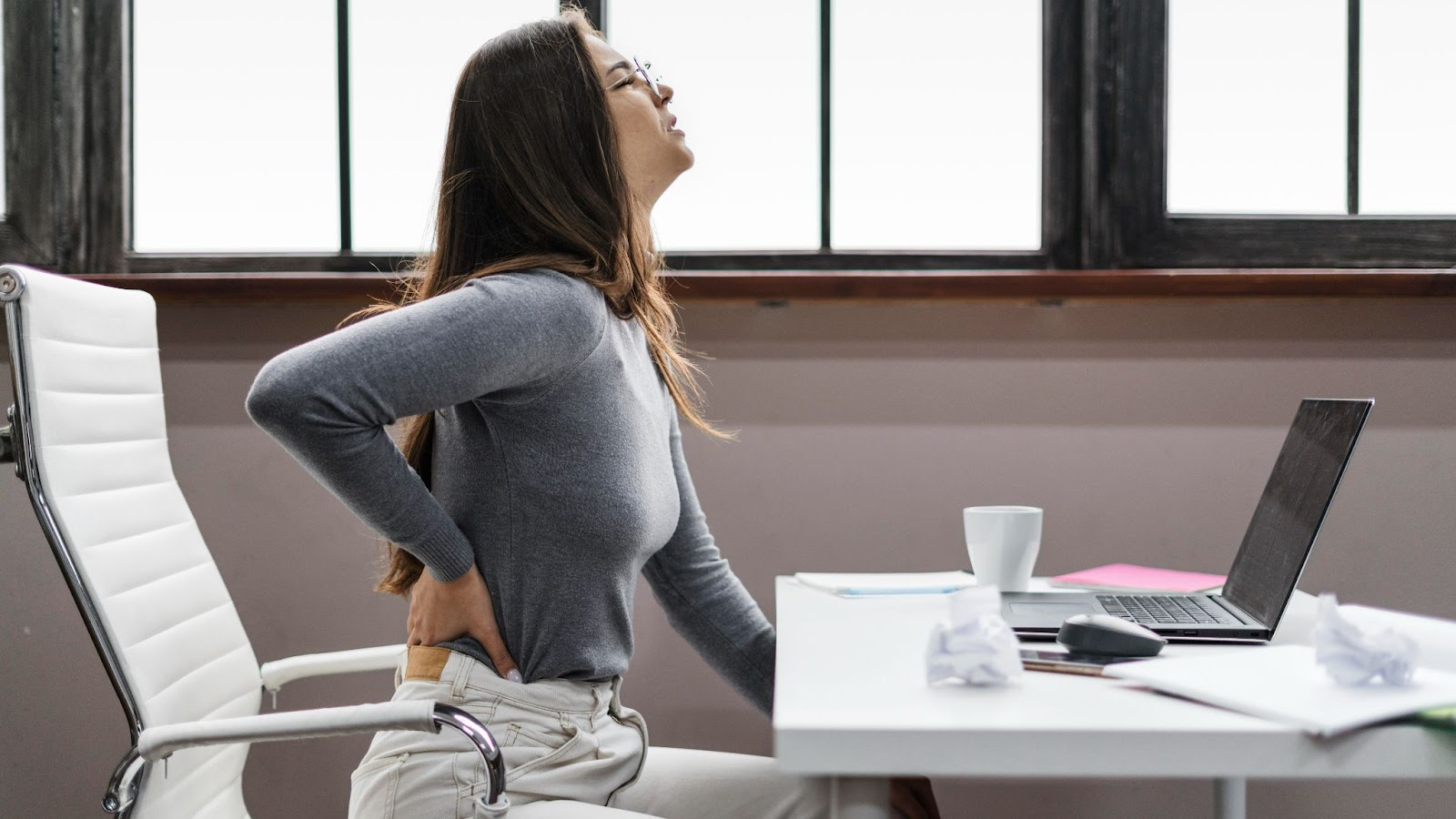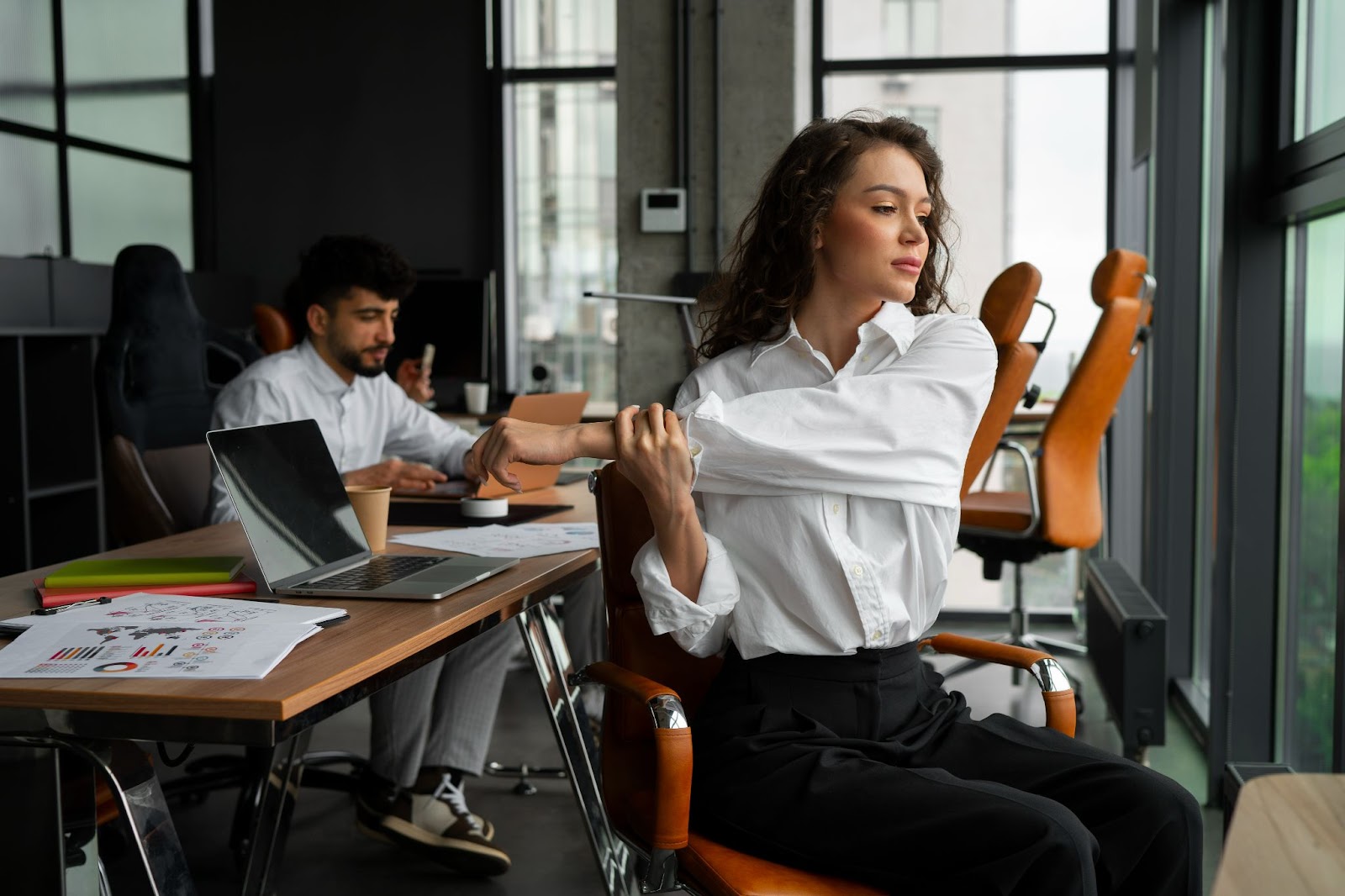Lower back pain that flares up while sitting but eases when standing is common among office workers and those with sedentary routines. Prolonged sitting can put extra pressure on the spinal discs, muscles, and posture, often making standing feel more comfortable by comparison. Knowing how extensive sitting conditions worsen lower back pain is useful in implementing specific approaches to eliminate and prevent the pain.
Understanding the Anatomy of Lower Back Pain
The Role of Your Spine and Muscles
The lower back, which consists of five vertebrae assembled with the intervertebral discs, relies on healthy muscular and ligamentous support as a source of maintaining posture. The stability of the spine is facilitated by core muscles, which include the transverse abdominis, obliques, paraspinals, gluteals, and hip flexors. These supportive muscles become strained and tired when sitting, and people experience back pain due to poor posture. During the passage of time, the discs and joints take in quite a lot of mechanical load rather than what they should take, leading to stiffness and pain.

Why Sitting Triggers Lower Back Pain

Increased Pressure on Spinal Discs
Sitting exerts 40-50 percent more pressure on the lumbar discs as compared to standing. A slumping or a slouching position increases this load further, which may aggravate the disc irritation or aggravate degenerative change. Extended compression impedes both the nutrition and flexibility of the disc, which heightens the chances of bulging, one of the reasons the lower back hurts while sitting, but not while standing.
Poor Posture and Muscle Imbalances
Seated position promotes pelvic anterior tilt, flexion of the lower back, as well as elongation of supportive muscles. Sitting slouched over a long period of time makes core muscles weak and hip flexors tight. These imbalances increase neural tension on the lumbar spine and the related fascia, leading to pain in the seated posture.
Reduced Blood Flow and Muscle Tension
When sitting, the blood circulation is restricted to the lumbar muscle, discs, and ligaments. Inadequate blood circulation decreases oxygen, which further causes fatigue and micro-tears of the muscle tissue. Without recovery of muscle, tension builds up, leading to sitting all day back pain.
Common Causes of Sitting-Related Back Pain
Herniated Discs
Herniated and degenerated lumbar discs may bulge further under pressure being exerted continuously. While people may feel discomfort while standing, lower back pain in office workers commonly worsens with sitting, especially when there’s compression of nerve roots or worsening of sciatica.
Sciatica
Sciatica is a term used to describe the pain, numbness, or tingling sensation that is a result of sciatic nerve compression. Although herniated discs or tight piriformis muscles may be contributing factors, when seated, the symptoms are worsened, so the individuals experience pain only when sitting as opposed to standing.
Muscle Strain and Weakness
With weak core and gluteal muscles, the spine becomes dependent on the structures that are under stress, such as discs and ligaments. Micro-damage and strain occur over time as a result of sitting in a position that relies on passive stabilisers and causes pain in the seated position.
Poor Ergonomics
Most of the offices have low-quality chairs where the spine is positioned in unhealthy positions due to a lack of lumbar support and improper height of desks. Poor ergonomic sitting position and unsupportive desks increase spinal strain, especially lower back pain, in office workers.
How to Relieve Back Pain from Sitting
Immediate Relief Techniques
- Stand and move immediately when discomfort starts.
- Apply heat to relax tight muscles or ice to reduce acute pain.
- Use a lumbar roll or support cushion on your chair to maintain natural spine alignment.
These are the tips on how to relieve back pain from sitting that are effective for early-stage discomfort.
Stretching Exercises for Desk Workers

- Hip flexor stretch: Kneel on one knee, shift pelvis forward gently.
- Seated spinal twist: Rotate torso gently to each side.
- Knee-to-chest stretch: Pull knees toward chest, lying on your back.
These stretching exercises help in relieving tension in the lumbar muscles and enhance flexibility.
Ergonomic Adjustments
- Use a chair with features such as adjustable lumbar support and seat height.
- Position your eyes level with the top of the monitor, and the keyboard should be at elbow height.
- Keep feet flat with knees at hip level and elbows relaxed at your sides.
Adopting a correct ergonomic sitting position can prevent stress accumulation and reduce sitting posture back pain.
Prevention Strategies
Proper Sitting Posture
Take a neutral spinal position, keeping shoulders soft, chin pulled in, and pelvis anteriorly tilted a bit. Do not slump or sit forward. Position arms on armrests, and alternate body positions every 20 to 30 minutes.
Regular Movement and Breaks
After every 30-45 minutes, rest, stretch, or take a short walk to break pressure and resume the circulatory system. This habit significantly helps prevent sitting all day back pain.
Strengthening Exercises
- To enhance core stability, practice planks, dead bugs.
- For the glute activation practice, bridges, and clamshells.
- For the back extension, practice supermans.
These strengthen postural muscles that support the lower spine and help spine endurance when seated.
These exercises for office workers with lower back pain build endurance and protect the spine during long periods of sitting.
When to Seek Professional Help
Seek the services of a spine or pain specialist when:
- Lower back pain does not respond to ergonomic manipulations and stretching.
- There is radiating, tingling, or numbness in the legs.
- You feel weak or have difficulties with the control of the bladder/ bowel.
- The pain is worse at night or otherwise disturbs sleep.
Early assessment assists in eliminating chronic pain and increases the chances of favorable outcomes.
Treatment Options at Alleviate Pain Clinic

At Alleviate Pain Clinic, we offer a comprehensive non-surgical approach, which involves:
- Imaging (MRI, X-ray, etc) and clinical assessment to determine involvement of disc or structure.
- Physiotherapy for spine stabilisation, flexibility, and to relieve back pain from sitting at the desk.
- Imaging-guided injections where there is swelling of joints or nerves.
- Basic rehabilitation, posture training, and ergonomic retraining.
- Regenerative medicine: prolotherapy or PRP in appropriate instances.
Our goal is to offer long-term relief and restoration of functional ability to people with lower back pain caused due to improper sitting.
FAQs
Sitting increases spinal disc pressure and strains postural muscles, especially with poor posture or weak core support. This compresses tissues and restricts blood flow, leading to pain that often eases when standing or moving.
Take short movement breaks every 30 to 45 minutes. Standing, walking, or stretching for even 2–5 minutes helps reduce disc pressure, restore circulation, and relieve muscle fatigue that contributes to sitting-related back pain.
Sit with your feet flat, hips and knees at 90 degrees, spine upright, and supported by a lumbar cushion. Keep your screen at eye level and your shoulders relaxed to maintain a neutral posture.
Yes, alternating between sitting and standing reduces continuous spinal pressure, improves posture, and increases circulation. A sit-stand desk encourages more movement throughout the day, which may ease or prevent sitting-related lower back pain.
Core-strengthening exercises like planks, glute bridges, and back extensions support spinal alignment. Stretches such as hip flexor release, spinal twists, and chin tucks improve mobility and relieve tension caused by prolonged sitting.




